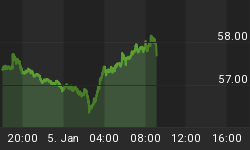Halloween is over, but I must say it has one of the most fear-laded fall seasons of recent memory. You'd have to go back to early October-November of 1998 to find a similar level of public fear and concern over the state of the global economy and markets. That of course was the end of one of the deflationary summer mini-crash of July-September in the stock and commodity markets, and it's ending resulted in the resounding stock market boom of late '98 through late '99.
Every day this fall leading up to the presidential election, it seemed, was greeted with some new worry, e.g., global and domestic economic or political concern, bearish ruminations of the longer-term trend of the stock market, questioning of the stability of the real estate boom, fear-mongering over terrorism, et al.
IMO, this was best summarized by a recent editorial cartoon appearing in the Washington Post. It showed someone riding in a row-boat down a winding stream with scary-looking monsters on both sides of the river bank. On each monster was a different sign reading "Presidential Election," "Terrorism," "Global Economic Slowdown, "Unemployment," etc. You get the picture. Suffice it to say, from a contrarian perspective this was a pretty loud and clear signal of the crescendo in the public's growing fear and worry. But as we know all too well, the market loves to climb a "wall of worry."
As a died-in-the-wool contrarian, I consider this lingering worry over just about everything to be a bullish psychological backdrop for the broad market. The more fear and worry, the more favorably the market seems to respond to it.
The front cover from the latest issue of Futures magazine is very interesting. As my long-time readers know, financial magazine covers often provide excellent contrarian signals of major market tops and bottoms.
The cover on this month's issue of Futures features the headline "Storm Warning!" and it depicts a hurricane motif with various financial and political symbols swirling within it. The feature of this month's magazine is an in-depth interview with the well-known super bear Bob Precther, of Elliott Wave fame. One thing I've observed over the years is that whenever a well-known bearish analyst is interviewed in the financial press it usually coincides with an important near-term market bottom. I don't think this is a coincidence since high-profile bearish analysts are synonymous with the bearish view, and it usually takes the media until the end of a downside move to become bearish, hence they start interviewing the bearish analysts.
 At the end of the Futures interview, Prechter was asked where he sees the S&P 500 by June 2005. His answer: "I'll be surprised if it's not a lot lower." Well there you have it, a contrarian signal for a bullish 2005!
At the end of the Futures interview, Prechter was asked where he sees the S&P 500 by June 2005. His answer: "I'll be surprised if it's not a lot lower." Well there you have it, a contrarian signal for a bullish 2005!
In his book, Don't Sell Stocks on Monday, Yale Hirsch showed that the middle year of the decade has produced a rather sizeable rally in the stock market in 11 out of 11 times, making it the strongest year in the so-called Decennial Pattern. Years ending in five from 1885 through 1995 have produced an average gain of over 25%! Hirsch has chronicled that the fifth years of the decade is where the vast majority of profits are made. He showed a total gain of 254 percent in the X-5 years, making these years among the very best of each decade.
The only reason I'm repeating this for the umpteenth time is because there is still a slew of articles making the rounds of the Internet as well as the bearish financial newsletters contending that 2005 will be a "down" year. From a fundamental and cyclical standpoint I do not share this bearish sentiment for the year ahead. I realize it's dangerous to forecast this far ahead since anything can happen between now and then, but I'm willing to venture that history will once again repeat itself and the X-5 year of 2005 will again be a winner.















